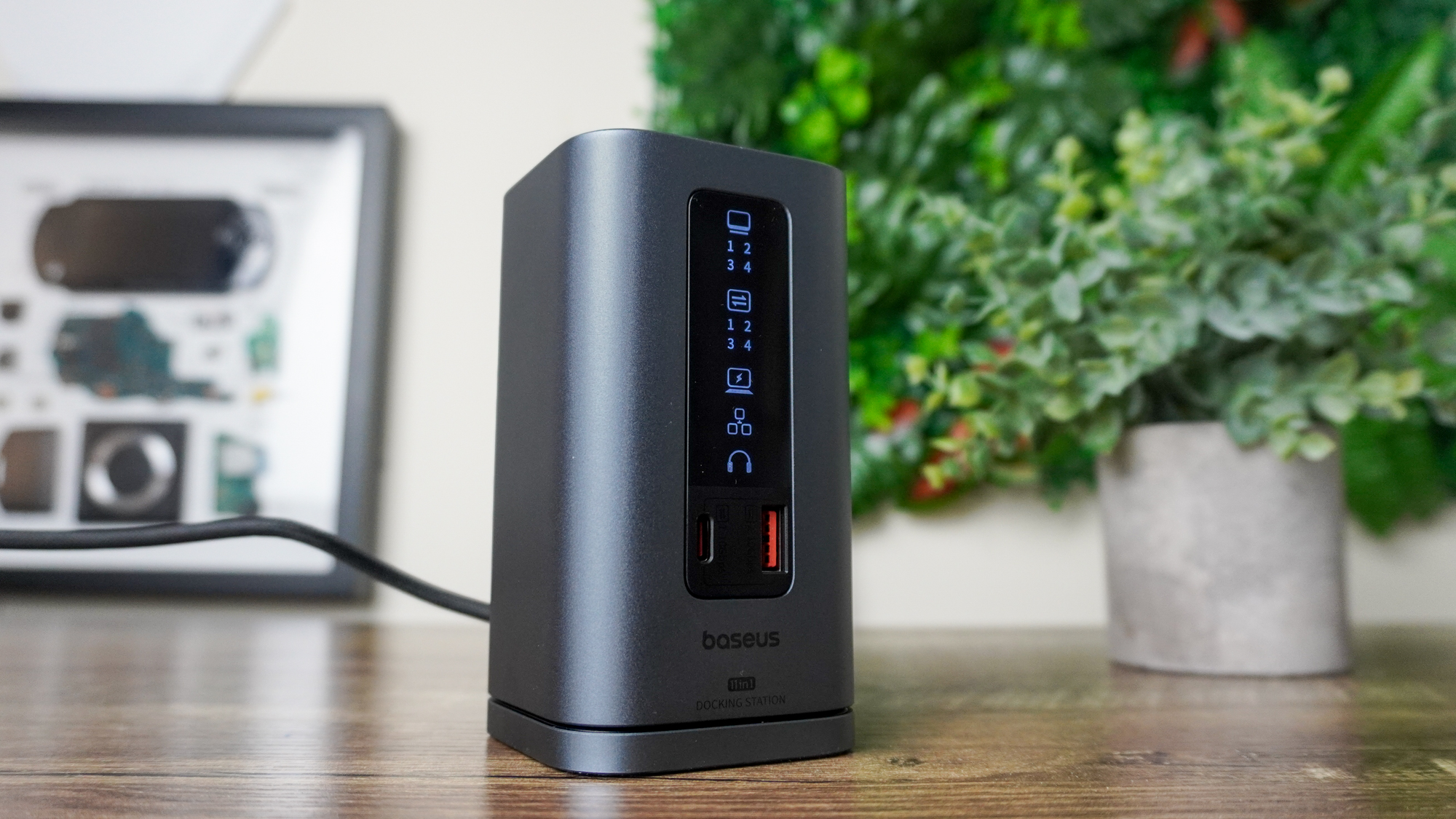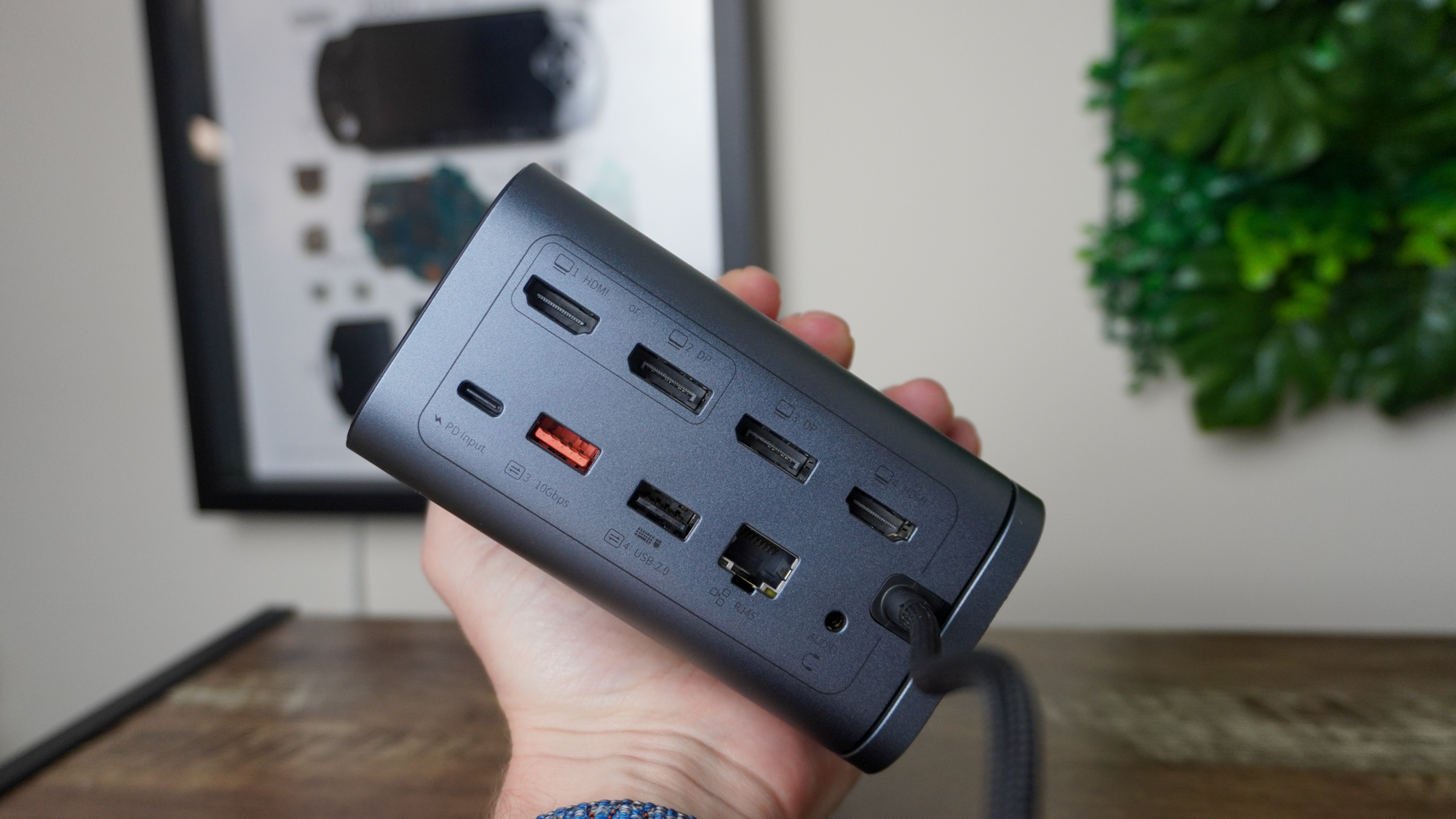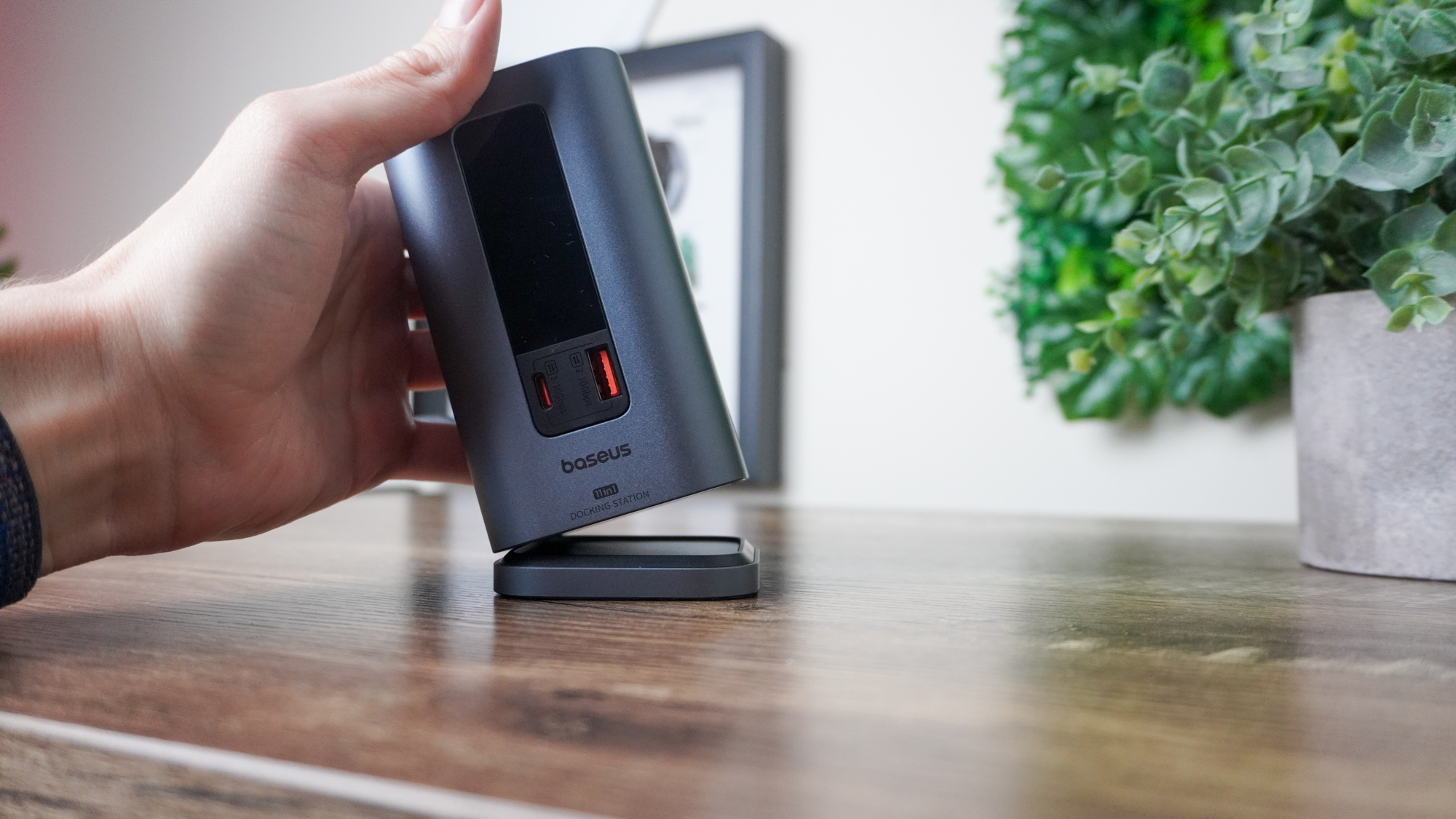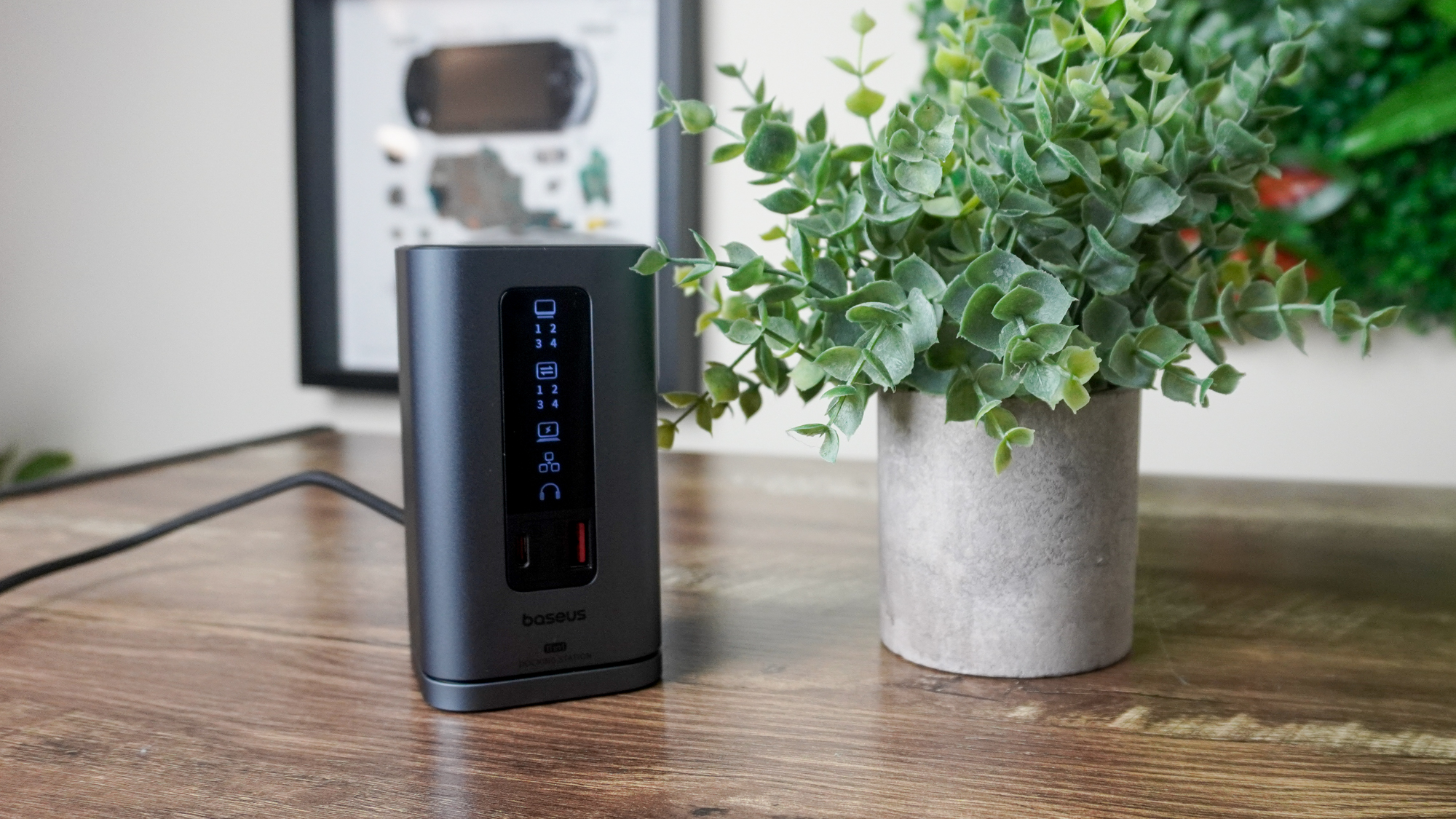
Remember when you first watched The Matrix? Yes, watching it back now, I crack a chuckle at the fact it’s a bunch of people pontificating about capitalism while wearing PVC. But it's still a spectacular watch, and when I witnessed the ridiculous multi-screen display the operator used, it became my dream to recreate it.
With that in mind, allow me to introduce you to the Baseus Spacemate 11-in-1 docking station — the hub that helped me achieve that vision. With two HDMI and two Displayport sockets on offer, this minibeast is capable of supporting up to three 4K displays at 60Hz. In reality, three displays was overkill for my workload, but damn it felt good to sit in front of this structure.
Not only that, but the stability of this rugged aluminum design (thanks to that sticky pad on the bottom of it eliminating any slippage), the digital display upfront showing you what ports are in action, and the unique screen lock button make this useful utilitarian package when it comes to those multiple screens.
Elsewhere, there are indeed other USB-A and USB-C ports (including 100W power delivery for your laptop) alongside gigabit ethernet. But this is where we start to run into problems, as the variety of additional ports is actually quite limited. Primarily, the SD card slots are missing, which means you’re not truly escaping from the dongle life with this piece of hardware.
I’ll give Baseus a pass on the display output being limited to just 30FPS in triple-monitor mode, as this isn’t really meant for gamers to take advantage of that additional framerate. But going back to that sticky pad, it is a double-edge sword. You better be comfortable with where it's placed, because after a few applications, that stickiness disappears and you’re right back to a slippery dock.
So with all that in mind, when it comes to the Spacemate, Baseus has created something great for the multi-monitor community. But it lacks that better balance of ports to really unlock usefulness for every use case. For that, I’d point you toward Plugable’s TBT4-UD5.
Baseus Spacemate 11-in-1 docking station: Cheat Sheet
- What is it? This is a USB-C docking station.
- Who’s it for? This is perfect for laptop users who want to plug into a multi-monitor desk setup.
- What’s the price? The Spacemate comes in at $199, but it’s regularly discounted to $129.
- What ports do you get? On this dock, you’ll find 2x HDMI and 2x DisplayPort sockets for handling the screens. On top of that, you have your USB-C port with up to 100W power delivery for your laptop, 3x USB-A, a second USB-C port for data, 3.5mm headphone jack and Gigabit ethernet.
- Are there any caveats to this docking station? While the Spacemate does shine in terms of multi-display usage, using it with a Mac is a little problematic as you can’t extend to that many screens. On top of that, the port versatility is a little lacking, so you will need additional dongles for elements like an SD card reader. For full compatibility, make sure you check your laptop specs, and reach out in Tom’s Guide forums if you have any questions!
Baseus Spacemate 11-in-1 docking station: Specs
Baseus Spacemate 11-in-1 docking station: What I like
If you’re a multi-monitor fiend, the Spacemate 13-in-1 is the way to go for all your monster setup needs with wide compatibility and hardware smarts for security.
So much display connectivity

Not just in the total amount of ports. I’ve seen docking stations with multiple HDMI and DisplayPorts just like this one. But Baseus’ tech unlocks the capability to connect up to three 4K monitors to it for an ultimate multi-monitor setup.
And in terms of setting it up, this is very much a “plug and play” situation — just connect the monitors in and you’re good to go. There’s a compromise in refresh rate, as the triple monitors will only be able to run at 30 FPS through this dock. But if your workload doesn’t require a faster framerate, this is truly a sight to behold when setup.
Screen security guaranteed

Say you’re using this in an office, or at home where you need to protect data from prying eyes. The normal rigmarole is to lock your computer or unplug your laptop from the docking station if you’re in a rush. That’s not the case with the Spacemate, and it all comes down to what I thought was a power button on top of the dock.
Turns out that is a screen lock button. You see what I mean when I say this is the best docking station for multiple screens? Baseus has thought of everything here! This was a great addition in those clutch moments of locking the screen from my nosy parents when heading to grab a coffee.
Just a quick heads up — for Windows systems, this is a single press. You’ll have to double-tap for Mac, but I can’t see that being too much of a problem.
Premium, useful design

With another nice block of aluminum, I’m really liking the utilitarian direction docking station design is going in. The Spacemate will take pride of place on your desk as an unassuming piece of tech that just blends into the background of your setup.
But to me, two key features stick out here. First, the display upfront gives you a nice subtle insight into what ports are connected. This is something that other companies should take note of, as it’s a handy indicator for port status when you’re dealing with a spaghetti junction of cable management behind it.
And second, that magnetic base with a sticky pad keeps this docking station rigidly locked in place. As I mentioned above, this is a double-edged sword, as the adhesive on that base can wear off after a few applications. But if you’re sure of where you want to place it, no amount of rubberized feet on the likes of the Ugreen Revodok Max 213 can match the staying power of the Spacemate when cables are pulling against it.
Oh, and shout-out to there being no power brick on this dock. In fact, it can run entirely on your laptop’s power supply, or even on the battery if you plan to take it with you somewhere. That made cable arrangement so much easier!
Baseus Spacemate 11-in-1 docking station: What I don't like
Taking the one-and-done nature of the adhesive magnetic base out of the equation, there are two key flaws here that may limit this from those who are looking for a more well-rounded docking station experience — rather than something that takes your display game to 100.
Mac support is lacking

This one is a little harsh, as both macOS and Baseus take equal responsibility here. But it’s worth noting that if you use this with a Mac, you’re not going to get that multi-monitor support — effectively locking Apple stans out of the biggest feature of this dock.
Plugging in three monitors, you’ll just see the second screen replicated across all three, which is a little disappointing given that we know multiple displays are possible. It’s just that the Mac landscape seems to be a challenge to work around. Whether you have a standard M3 or earlier with its single external monitor support, or if you have a Pro/Max and need a Thunderbolt 4 dock to do this.
Port variety is lacking
This is not about the number of ports. There are plenty to get you going, including various USB-A and USB-C sockets, gigabit ethernet and a 3.5mm audio jack. But rather that if you’re looking for a more versatile arrangement for workloads, this ain’t it.
For example, there is no SD card reader here. Sure, you can buy a dongle for that, but then the whole point of a docking station is eliminated — you’re back to a mess of cables and boxes on your desk.
Baseus Spacemate 11-in-1 docking station: Verdict
So what are we dealing with here? The Baseus Spacemate 11-in-1 is a solid docking station for the multi-monitor enthusiasts. The plug-and-play nature is great, the simplicity of the design is even better, and with all the I/O you need to get this off the ground, you can feel like you’re hacking into the Matrix in minutes.
But Mac compatibility woes, the one-time adhesiveness of the magnetic base, and the lack of port variety stop it short of being the best use of that $200 for an all-rounder docking station. This one’s for the triple display enthusiasts only.







